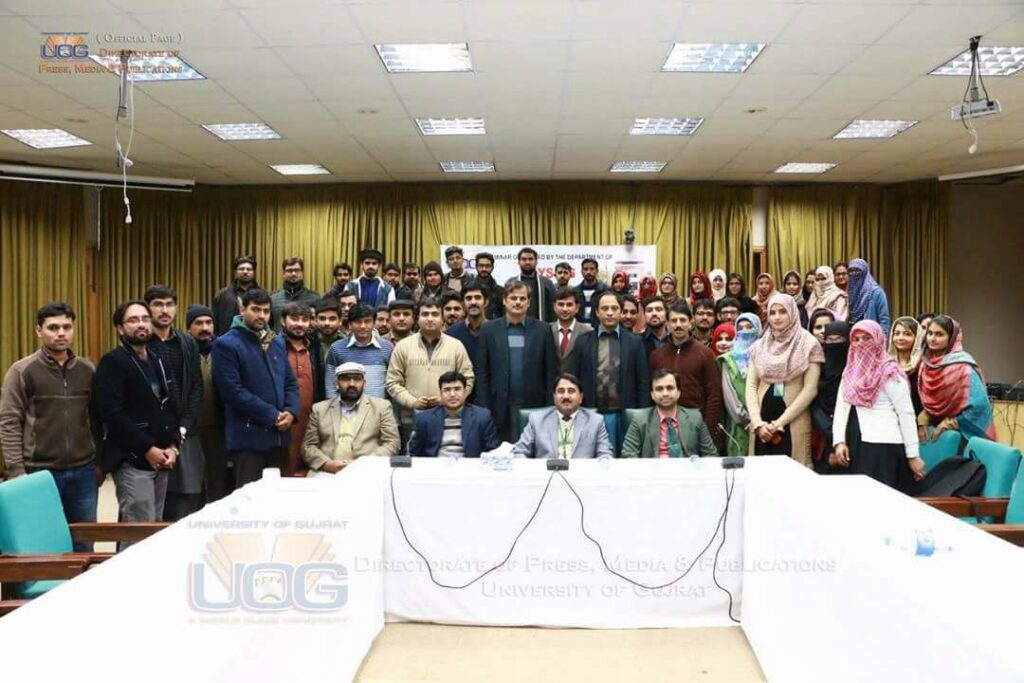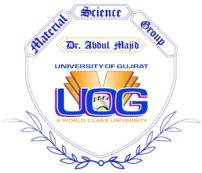Material Science Group's Newsletter-2017

Editorial Board
Dr. Abdul Majid (Group Leader)
Ms. Alia Jabeen (Editor)
Mr. Irslan Ullah Ashraf (Research Assistant)
Our mission is searching scientific solutions to the problems faced by society
Table of Content
1. Editorial
|
2. About the group leader
|
3. Research assistant
|
4. Opinion of Research Assistant (Mr. Irslan Ullah)
|
5. Research facilities
|
6. About students
|
7. Group discipline
|
8. Events
|
9. News
|
10. Future planning
|
11. Publications |
1. Editor
First principles calculation has become a reliable tool to predict the material properties and develop understanding of scientific mechanism. Despite extensive experimental activities to produce new materials, comparatively less attention has been paid to DFT study of these materials. The calculations help to model the experimental realities in order to understand the material’s structure-properties relationship on electronic and atomic level. The DFT study is known to help save time, energy and financial resources of experimental material scientists. The modern computational systems offer theoretical predictions of materials suitable for any requirement; therefore, out of hundreds possible configurations of materials, the most appropriate systems can be selected for experimental testing. However, the survey of literature points disagreements among reported studies on same materials which put questions. In the recent past, an increase in number of researchers and groups working on free and commercial DFT codes has been observed which has its own impact on the literature. The computational recipe should be carefully decided in order to cope with such matters.
2. About the Group Leader
Dr. Abdul Majid, started this research group in 2010 while initiating work on semiconducting and diluted magnetic semiconductors for spintronic applications in the frame work of Density Functional Theory (DFT) by using ADF based programs. The motivation has been his stay at Institute of semiconductor physics, Beijing, China as senior research associate, where he carried out detailed study of ion-implanted compound semiconductors. He studied structural, optical, electrical and magnetic properties of pure and implanted materials to record some un-usual results which always challenged him to interpret. Therefore, upon joining university of Gujrat, he established a computational physics laboratory in the department of physics and started work on using DFT formulism. In addition to simulating his previous experimental results, he extended studying new materials with his students and published in reputed international journals.
He has special interest in realization of diluted magnetic semiconductors which are potential materials for optoelectronic and spintronic devices. During recent past he studied RE doped GaN using experimental and computational techniques and published several reports on DFT based study of such materials. He has discussed in detail the results on doping induced effects including substitution, band gap narrowing, hybridization, modification in band structure, emergence of impurity induced levels, induction of ferromagnetism and change produced due to shift of fermi level. Considering the rising worldwide energy crises, he has recently started working on energy materials and devices. The initial work in this category include electrode materials for lithium ion battery and dye sensitized solar cells.
3. Research Assistant
Mr. Arslan ullah Ashraf has been appointed as research assistant for the project named as “Computational Study of TM:SiC Alloys to Design Efficient Material for Counter Electrodes to be Used in Dye Sensitized Solar Cells” after completing their MS from the same university and same lab.
4. Opinion of Research Assistant
The energy crisis is the question of the day for the researchers throughout the world. As the demand of energy sources has been increased of the threatening level with the increase in population. The natural sources (coal, nuclear sources) are being depleted with the utilization. So it’s the need of an hour to work on the renewable energy sources. In this context, it should be kept in mind that the energy sources must be clean, safe and cost effect.
The DSSC, hydrogen generation, and various batteries are of great interest for the researchers working on the energy resources. One of them are rechargeable lithium ion (Li-ion) batteries. These batteries are characteristic rechargeable energy devices having unprecedented rank in the present day technology. It is being utilized as primary source in the portable energy devices. It consists of cathode, anode, electrolyte and a separator. The basic principle of charging and discharging is the intercalation of lithium ions between cathode and anode. Hence, the cathode materials are considered as chief contributors for almost half contribution in the lithium ion (Li-ion) batteries. Cathode materials are very complex in which several spontaneous structural as well as the phase transition occurs. Also, the improved performance of Li-ion batteries is directly linked with that of the performance of cathode. Hence it is necessary to establish the chemically stable and cost effective cathode materials. Several features such as power density, energy density, stability of cathode materials are of great interest for researchers now a days. Various materials utilized for the cathode of lithium-ion batteries are chalcogenides, tavorites, layered oxides, olivine phosphate and spinal oxides etc. Olivine phosphate ) is one of the well-developed material utilized as a cathode material in (Li-ion) batteries.
Theoretical approach is the tool to study the theory in physics, chemistry as well as in material investigation, used to solve many body problem, study the electronic problem, core potential and ground state energy. DFT is one of the successful quantum mechanical approach to investigate the matter and the material properties. It is an approach (farther as compared to HF formalism) that involve the correlation effects within the materials that provides the accuracy at same computational cost. It is utilized for a wide range of the materials in order to generate ground state that belongs to a specific system, providing the accurate results in accordance with that of the few percentage of the experimental data.
Featured Research in 2017
We are focusing to increase the electronic as well as the ionic conductivity in olivine phosphate. It was assumed that energy density and power density can be tuned by substituting Fe with rare earth metals. The electronic and ionic properties are being studied by replacing Fe with Ce and Gd respectively. The electronic properties of reveals an increase in the electronic conductivity of the (Li-ion) batteries. The ionic conductivity was addressed by replacing the Gd with Fe in LiFePO4 . For the ionic conductivity, the NEB calculations are being performed. The calculations revealed the enhanced ionic conductivity of the LiGdPO4.
As discussed above, the vital role of this research work was to improve the electronic as well ionic conduction of li-ion batteries. Therefore, a detailed research was done and complete substitution of Fe was performed with potent rare earth metals, Ce and secondly Gd were investigated in detail through first principles approach. Periodic bulk with supercell approach was used in order to study the doping effects at Fe sites. In the first step, the Ce was completed substituted against the Fe sites and the electronic as well as ionic properties were studied. The electronic properties of Ce doped material (LiCePO4) tune the band gap of material in such a way that the band gap completely vanishes and the material behavior of LiFePO4 from semiconductor was turned into metallic nature due to Ce complete substitution. Moreover, in this sense, it was concluded that the electronic properties are enhanced due to barrier faced by electrons in terms of band gap in LiFePO4. A comparative analysis of electronic properties are shown below
In the next step, the NEB calculations were performed for the study and improvement of ionic conduction
The effect of externally applied magnetic field on the cathode material “olivine phosphate” is also an important factor to study. Hence, paying attention on this topic.
Molecular Clusters:
We also have started work on the cluster to investigate the structural, vibrational and optical properties of metallic hybrid clusters.


5. Research Facilities
The majority of the students in this research group are working on various energy materials using DFT implemented in various codes installed in core i-7 computers. The students willing for experimental work also encouraged to do so.
CODES:
1. ADF
2. ADF-BAND
3. Reaxx-FF
4. Molecular Dynamics (MD)
5. DFTB
6. COSMO-RS
7. UFF (Universal Force Field)
8. GUI (Graphical User Interface)
9. Mopac
10. MM
Their functionality and other details could be found at www.scm.com
6. About Students
i) Irslan Ullah Ashraf
Mr. Irslan Ullah is currently working as Lecturer Physics in department of Physics, University of Gujrat, Pakistan. He is also working as Research Associate in HEC funded Research Project “Computational Study of TM:SiC Alloys to Design Efficient Material for Counter Electrodes to be Used in Dye Sensitized Solar Cells” with the group head. He did M. Phil in Physics from same department while working in the field of energy storage devices and materials. His attempted to improve the performance of Li ion batteries using computational techniques mainly DFT and Molecular Dynamics. Prior to this, he earned B.S. in Physics from same department while working on monolayer materials especially Gd doped MoS2. He has been coordinating his research group, helping the group fellows to carry out their research and administering the computational infrastructure in his research group under supervision of Dr. Abdul Majid who is also Principal investigator of the project mentioned above. His research interests include computational study of material science with focus on semiconductors, energy materials and devices.
Email: irslan.ullah@uog.edu.pk

ii) Naeema Rani
Miss Naema Rani is young energetic researcher and recently she is doing her research work of MPhil in condensed matter physics, department of Physics, University of Gujrat. Her area of interest covers the most emerging field ‘Spintronics’ since a seminar has been conducted on the same field by the Chair of Department in University of Gujrat. Recently she is doing research for TM: SiC to be used in Spintronics devices. She did her BS from same department and her research work was on DFT study of electronic properties of LiCePO4 as a cathode material for upgradation of lithium ion batteries. During this work she published a review paper on ‘A review on first principles-based studies for improvement of cathode material of lithium ion batteries. Nevertheless, she is young and very new in the field of Spintronics, she is paying her worth role to investigate new materials to be used in the emergent technology.

Research as conducted by Mr. Irslan Ullah during 2017-2018
This phase of my research carrier is very exciting in which I turned towards energy devices which are real hopes for the future of humankind. I have chosen to work on energy storage materials especially materials involved in lithium ion battery. The literature review motivated me to investigate olivine phosphate as good choice to work with as Li ion battery cathode material. I faced problems to optimize its structure and understood its complex structure. In addition to study the electronic properties of the cathode material, I employed Molecular dynamics simulations to calculate the power density of the electrode. In addition to this, I utilized Nudged Elastic Band Method to find the hooping barrier and diffusivity for the desired electrode material. The calculated
diffusion barrier for hopping of Li ion in LiFePO4 is sketched in figure
I planned to modify the LiFePO4 material with RE metals Gd & Ce as LiGdPO4 and LiCePO4 to analyze its power density and stability. I thought that Gd will be good choice to facilitate the motion of Li ion in the crystal because Li, Gd belongs to rare earth series and these are well known because of their huge sizes and immense columbic potentials so lattice expansion in the GdO6 octahedral is expected. The high electronegativity is also expected to increase the overall stability of the material. In order to understand the mechanism involved, I performed complete analysis of electronic and magnetic properties of the structure and calculated the steric interaction and electron localization function (ELF) analysis. I also calculated the intercalation potential of the material. On the basis of our experience on such systems, it is found that RE could be a good choice for electrode material however the lattice expansion could affect its stability that could be overcome by co-doping with TM metals like Fe, Co and Zn. The story is not yet completed and the work is in progress in our group.


Research using the Nuged Elastic Band Method
After using several tools to theoretically investigate the properties of materials, I came to know that Nudged Elastic Band (NEB) method is highly resourceful tool to study the physics and chemistry of materials since it helps to calculate the rate of reactions, transition state, and reaction barriers etc. The
application of this technique helps studying the potential energy surfaces, stages of reaction by monitoring the reaction parameters in very simple and efficient way. This is advance form of basic, chain of states or method of images in which different intermediate images (structures of intermediate reaction states)determine the minimum energy path between two predetermined minimized energy states such as shown in figure.
In this technique we use different images to guess a reaction path to guess the minimum energy path and transition state (mostly the exited state) of a reaction. These images are connected by small spring connector that gives the nudging effect to the reaction states and lead them to the next reaction state by following the minimum energy path. This is not first principles based iterative minimization process that gives a completely downhill movement energy path. Since it requires optimization of different (desired) images so it is computationally expensive method. However, understanding and implementation of this method gives a useful skill to explore variety of properties. The most common problem arises when transit species come very close to any nearby atom that could excite the state above the limits and stops the calculation. This could be overcome by accurately designing the intermediate image files. We could also perform the calculation by freezing the atoms that don’t have negligible effect on the transiting species and this is successful in large supercell which saves the computational cost effectively. However, one could face more elegantly the problem of atoms come too close while implementing this approximation.
We can save our time while calculating the NEB at basic quality first and then extending it to the high quality in order to determine the accurate rate of a reaction. The first run will show if the calculation path we adopt is possible or not also it will initialize the system to optimize faster. There is no short cut to determine the energy barrier otherwise.
Research as conducted by Ms. Naema Rani during 2016-2017
Spintronics, also known as spin-electronics, is a new emerging field that utilizes the spin of electron with its charge to oppress the classical-quantum and computing information technologies with less consumption of power and greater rate of speeds. Impressively the transport of spin degrees of freedom in both metals and semiconductors is fundamental research interest not only in the solid-state field but also in the electronic technologies. The common application of Spintronics is Gaint magneto resistive (GMR) which is available in the market in the form of alternate ferromagnetic (FM) and nonmagnetic (NM) layers. The device resistance changes with alternate small and large magnetization in the NM and FM layers respectively. Therefore, variation in the resistance is utilized for sensation of magnetic fields. Now a days the recent research is to produce the magnetic tunnel junction in GMR devices in which the tunneling current strictly depends upon the spin orientation of device.
Moreover, recently two type of efforts are highlighted in this research area. The first one is to enhance the spin polarization of electrons in order to get perfect GMR technology. Whereas, the second and important approach is to find novel materials with boost generation and utilization of spin polarized currents. This way represents totally the semiconductors that reveal efficient spin polarization. The concept behind this fact is that the metals based Spintronic materials are not considered as best source form signal amplification, while the semiconductors based devices are principally best for amplification purposes.
7.Group Discipline
Patience and Practice are key elements to handle the research problems in this group with the secret of success lies in study, study and study. It is expected for every student to maintain the group discipline thereby keeping the group and supervisor informed on their activities by submitting weekly, monthly and semester reports on prescribed format. The students have to present their work in group meetings where rigorous discussions are made to improve the quality of research.
The majority of the students are working in the field of DFT which demands in-depth understanding of relevant knowledge. A list of assignments is given to every student in the start of research which are essential to understand and explain in presentations. The set of assignment that consists of three parts; A, B and C. Part A consists of the theory and basic knowledge about the field. Part B is about the codes and calculations. Part C consists of the particular topic on which the student is supposed to work.
8. Events
Spintronics is an emerging and an up-growing research field in which the spins of the electrons are being controlled to develop new electronic devices. Considering the importance and significance of this emerging field, a seminar, entitled as “DFT approach in SPINTRONICS”, was organized by the department of Physics, UOG. In this seminar, Dr. Abdul Majid given invited talk to the students and faculty of the entire department in video conference hall on the topic

9. News
· This research group won the HEC fully funded NRPU Project titled “Computational study of TM-SiC alloys to design efficient material for counter electrodes to be used in dye sensitized solar cells”
· Mr. Arslan Ullah successfully proceeded his MPhil Defense. Congrats!
· Miss Naema Rani successfully defended her BS Final Defense.Congrats!
· Mr. Waqas joined our group as an MPhil scholar Welcome!
· Mr. Muhammad Saim Raffique joined our group as a new MPhil scholar Welcome!
· Miss Saddiqa Habib joined our group as a new MPhil scholar Welcome!
· Miss Nadia Parveen joined our group as a new MPhil scholar Welcome!
· Miss Bakhtawer Saddiqa joined our group as a new MPhil scholar Welcome!
·
Miss Amber
Batool joined our group as a M.Sc Research student. Welcome!
·
Miss Alia
Jabeen joined our group as a M.Sc Research student. Welcome!
10. Future Prespectives
Taking into consideration the latest research questions and especially the energy resources, we are planning to work on the following,
- Counter Electrode for DSSC
- Anode of Lithium Ion Batteries
- Molecular Clusters
11. List of Publications
- Majid, A., Ahmad, N., Khalid, N. R., Shakil, M., & Zhu, J. (2017). Effects of transition metal ions doping on optical and electronic properties of GaN. Journal of Materials Science: Materials in Electronics, 28(14), 10596-10602.
- Majid, A., Azmat, M., Ahmad, N., Hussain, F., & Nabi, G. (2017). A DFT study of electronic interactions in Ti: AlN: GGA and GGA+ U approaches. Journal of Magnetism and Magnetic Materials, 432, 351-355.
- Shafqat, A., Iqbal, T., & Majid, A. (2017). A DFT study of intrinsic point defects in monolayer MoSe2. AIP Advances, 7(10), 105306.
- Firdos, M., Hussain, F., Imran, M., Ismail, M., Rana, A. M., Javid, M. A., … & Ullah, H. (2017). Ab initio study of ceria films for resistive switching memory applications. Materials Research Express, 4(10), 106301.
- Majid, A., Ahmad, N., Awan, T. I., & Javed, M. (2018). A Computational Study of Ferromagnetic Exchange Interactions and Charge Transfer in Codoped Gallium Nitride. Journal of Superconductivity and Novel Magnetism, 31(2), 475-481.
- Majid, A., Ahmad, N., Rizwan, M., Khan, S. U. D., Ali, F. A. A., & Zhu, J. (2018). Effects of Mn Ion Implantation on XPS Spectroscopy of GaN Thin Films. Journal of Electronic Materials, 47(2), 1555-1559.
- Majid, A., & Bibi, M. (2017). Computational study of titania-ceria hybrid clusters for electrochemical applications. Journal of Nanoparticle Research, 19(7), 246.
- Majid, A., & Bibi, M. (2017). First principles study of vibrational dynamics of ceria-titania hybrid clusters. Journal of Nanoparticle Research, 19(4), 122.
